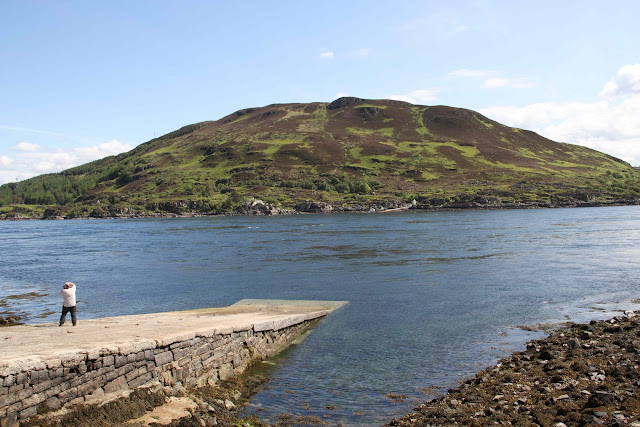Five of us went in search of "some really nice rocks" at Glenelg on 5th June 2012.
Looking eastward from the Isle of Skye across Kyle Rhea to the beach at Bernera, near Glenelg on the Scottish mainland.
Looking across Kyle Rhea at the crossing of the Glenelg ferry. There's a very rapid current here.
The wee ferry on its way
Looking back at the granite intrusions on Skye
The estuary of the River Glenmore
And so to the rocks on the pebbly beach at Glenelg.
An igneous rock with iron-containing minerals
To me this looks like layers of marble (with a pink mineral) in a grey sedimentary rock. This might be true if it's possible that limestone can leach into crevices in sedimentary rocks or is an actual sedimentary layer itself, and that the pressure (and associated heat) created by subsequently accumulating sedimentary layers is sufficient to convert the limestone to marble. It's more likely perhaps that the marble (if it is marble - I think Jo suggested it was something else) was created through heat transmitted from an adjacent igneous intrusion, which would mean that the grey rock, in spite of its layered appearance, is igneous. From the platform of almost total ignorance one can speculate almost indefintely and equally fruitlessly about the most trivial of geological observations. But therein lies the fun and the frustration. Judy has since stated that the seams in this and the following image comprise quartz, formed from the oxidation of silica-containing solutions.
More of the same. What I don't understand is how one can get layers of marble within igneous rocks. One would imagine that the marble is formed in bulk at the aureole (zone of heat transference) around the igneous intrusion, though perhaps in this region there is some interpenetration of the magma and limestone.
Speculations invited
The orange material is lichen but the pink is a mineral.
A closer look at the pink-red mineral which has been allocated a variety of speculative identifications by members of the group, with Jo proposing biotite and Faye stilbite.
Perusing pebbles
Many of the pebbles were coated with tiny particle of shiny material, moreso than the one above. Faye says the material is mica.
Same pebble
Looks like a conglomerate
On the way back, looking north east over the eastern end of Loch Duich, we spy the Giant's Hand, which I think is substantially bigger than Jo's Lion.
















